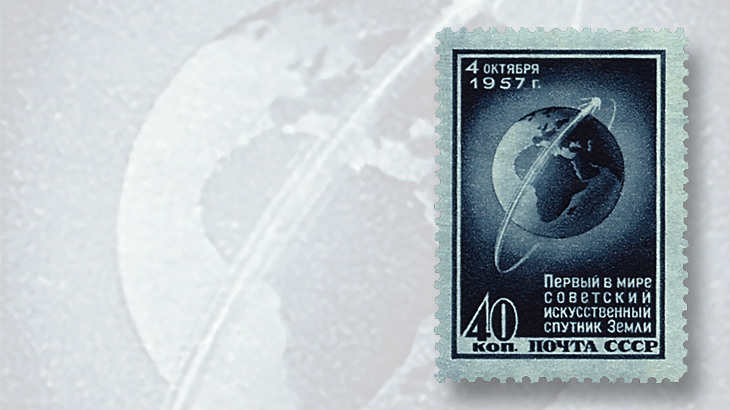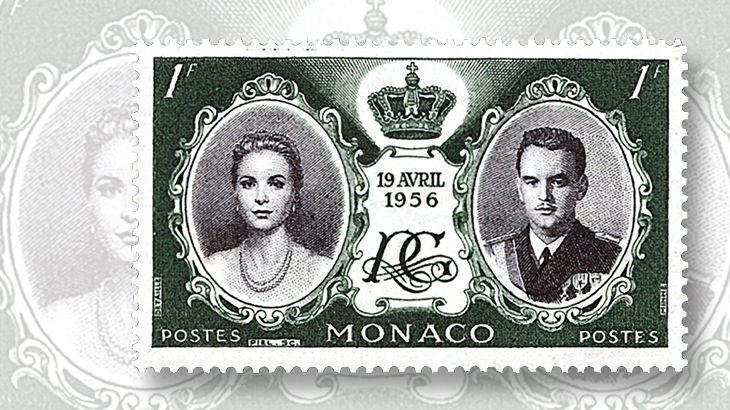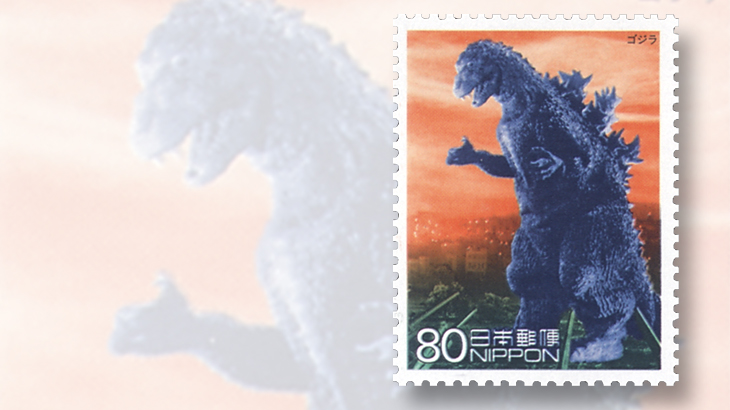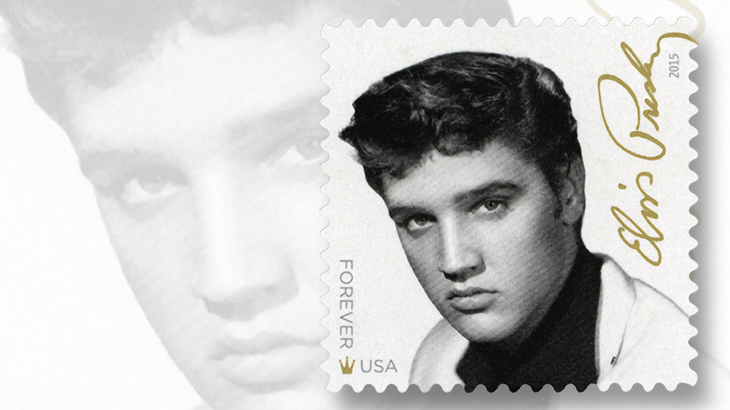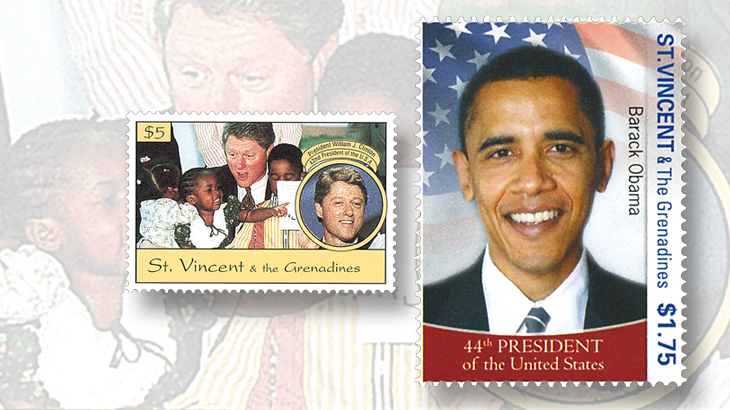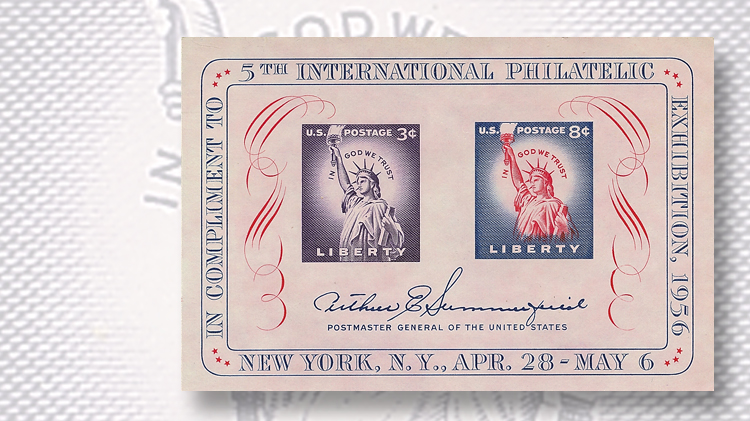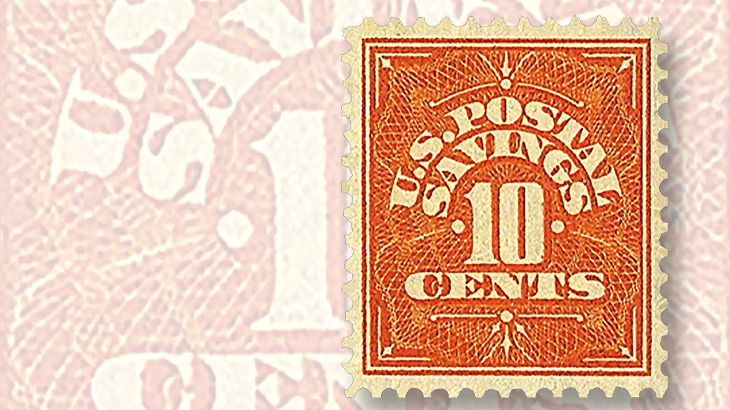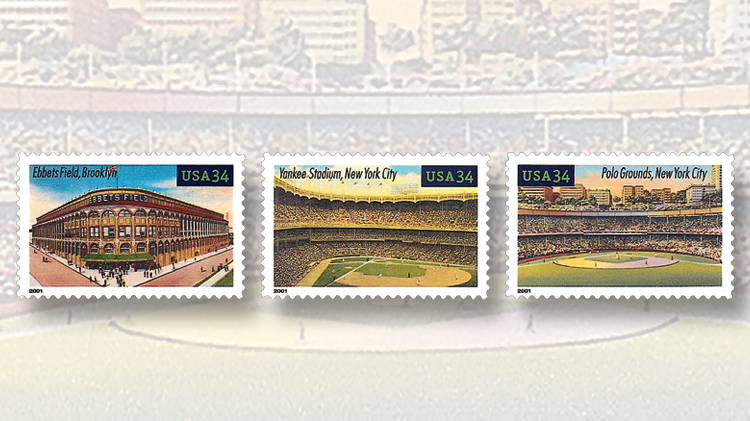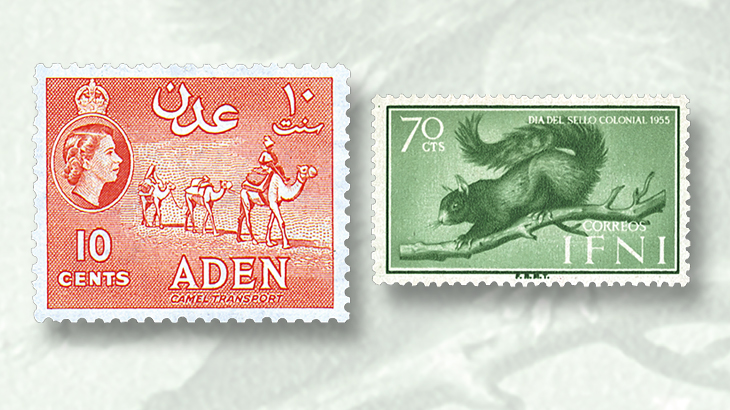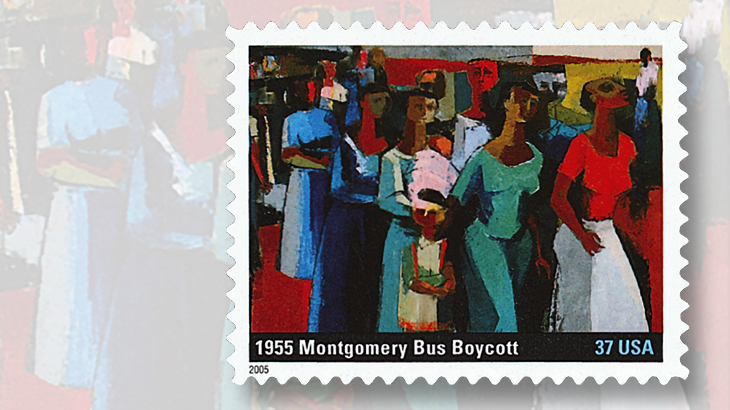World Stamps
So what’s happened since the last New York international stamp exhibition?
By Martin J. Frankevicz
It’s been a long time since an international stamp show has been in New York City. All told, it’s been 60 years — a time when “We have a really big shoe for you” was a catchphrase made famous by Ed Sullivan, back in in the early years of television. For stamp collectors and dealers, that’s what an international show is — a really big shoe.
As noted on the margin of the United States Fifth International Philatelic Exhibition souvenir sheet (Scott 1075), the last international show in New York City ran from April 28 to May 6, 1956. Fipex, along with the New York International Auto Show and the National Photograph show, christened the brand new building shown on U.S. Scott 1076 — the New York Coliseum.
Only one international show is awarded to the United States every decade. In 1926, 1936 and 1947, New York City was the host. This made sense because New York City was a major transportation hub, the main port of entry into the United States, and the heart and soul of a thriving American philatelic marketplace. Nassau Street in lower Manhattan was a literal stamp-shop district that sprang up a short stroll away from Wall Street, where all the financial high-rollers (and stamp shop customers) did business.
Connect with Linn’s Stamp News:
Like us on Facebook
Follow us on Twitter
Keep up with us on Instagram
But in 1966, New York’s string of internationals ended when the Sixth International Show (Sipex) was held in Washington, D.C. The bicentennial spirit of Philadelphia made that city the natural choice to host Interphil in 1976. Chicago hosted perhaps the biggest international show held on U.S. soil, Ameripex, in 1986. San Francisco hosted the only international show on the West Coast, Pacific 97, and the nation’s capital again hosted Washington 2006.
A lot has gone on in the 60 years since New York City hosted Fipex. Looking at what had happened historically before this 1956 international stamp show and what came after truly points out how different the world was then.
When Fipex opened, Robert F. Wagner Jr. was in the third year of his first term as the mayor of New York City. Later on that year, Wagner ran for the U.S. Senate against the attorney general of the State of New York, Jacob Javits. Though he lost to the liberal Republican Javits, Wagner served two more terms as mayor. Javits served as senator from 1957 to 1981, and is the namesake for the convention center hosting World Stamp Show-NY 2016.
The year of 1956 was a presidential election year as well. President Dwight D. Eisenhower was running for his second term, along with his vice president, Richard M. Nixon. He had no opposition in the primaries or at the Republican convention, held in San Francisco in August.
Eisenhower would eventually face his opponent in the 1952 election, Adlai Stevenson. Stevenson had some challengers, most notably Senator Estes Kefauver of Tennessee. Two weeks after Fipex closed, Stevenson and Kefauver would engage in the first televised campaign debate. Stevenson eventually won the Democratic nomination, and would pick Kefauver as his running mate. Eisenhower and Nixon won their second terms in November.
New York City in 1956 had the world’s tallest building — the Empire State Building. It held that title since it opened in 1931 and would hold onto the title until the Twin Towers of the World Trade Center surpassed it in 1973. When Fipex opened, plans for New York’s great performing arts complex, Lincoln Center, were in their initial stages. The area was slated for urban renewal, but it wasn’t until June 1956 when Lincoln Center would be incorporated. The groundbreaking for the complex didn’t happen until 1959.
More stamp exhibition news:
New York has always been a place in a state of constant renewal. The main shaper of New York City during from the 1930s through the 1960s was not a mayor, not a state governor, but a man far more powerful person who was never elected to any office whatsoever. His name was Robert Moses, and he had his hand in virtually every major project in the New York area.
Moses was an important person in both of New York’s World Fairs in 1939-40 and 1964-65. The old Coliseum and Lincoln Center wouldn’t have been built without Moses. He was responsible for building most of the major interborough bridges and highways in the city. He built the parkways on Long Island and in Westchester, which allowed people to leave the city and get a plot of land in the suburbs. However, all of the money he lavished on road projects allowed the slow decay of the New York City subway system.
When Fipex was held, it was the beginning of baseball season in New York. The city had three great baseball teams, which dominated the sport in the 1950s. The World Series was played somewhere in New York City, and usually in the Bronx, every October from 1950 through 1958 (from 1920 to 1964 there were only 12 years when there wasn’t a World Series game played in New York City). The reigning World Champions were the Dodgers team of 1955, with Jackie Robinson, Roy Campanella, Duke Snider and Don Newcombe, who won their first World Series, beating the Yankees.
The Yankees, a team with Mickey Mantle, Yogi Berra, and Whitey Ford, turned the tables on the Dodgers by beating them in October 1956, and added a cherry on top of it when little-known Don Larsen pitched the only post-season perfect game. Alas, 1956 would be the penultimate season for two of the New York teams. The Brooklyn Dodgers packed up for Los Angeles, and the New York Giants left for San Francisco to start the 1958 season, a sore subject still for many an old-time New York sports fan.
For New York professional football fans, the 1955 season was a bit of a disappointment, because the Giants missed the playoffs. The 1956 season would bring the team a championship, however. Helping the Giants was the league’s most valuable player, Frank Gifford. Two of the assistant coaches for the 1956 Giants would later become legendary head coaches for other teams — Tom Landry and Vince Lombardi.
In 1956, college basketball was far more popular in New York City than professional basketball. St. John’s University, Seton Hall, and City College of New York were basketball powerhouses in the early 1950s. The National Invitation Tournament was held in New York City, and was a far more prestigious post-season tournament than the NCAA tournament during the early 1950. But by 1956, the NCAA tournament was beginning to receive more respect.
When it came to professional basketball, the National Basketball Association was a young league comprised of only eight teams in 1956, two of which were in places like Rochester and Fort Wayne. The New York Knickerbockers and Boston Celtics still had not won a league championship. The NBA’s biggest stars in 1956 were George Mikan of the Lakers (when they were in Minneapolis) and Bob Cousy of the Celtics. Legendary players Bill Russell and Wilt Chamberlain were still playing college ball in 1956.
The year 1956 was an Olympic year. The Winter Olympics were held in late January and early February in Cortina d’Ampezzo, Italy. The United States took two gold medals — in the men’s and women’s singles in the figure skating competition.
The Summer Olympics would take place in late November and early December, when it was summer at the host city, Melbourne, Australia. Because of Australia’s quarantine laws for horses, the equestrian events were held in Stockholm in June. The United States took home 32 gold medals, half of which were won in track and field events. The basketball team won its fourth straight gold medal.
Fipex took place when broadcast television was still rather young. Most of the sets in people’s homes were black-and-white. Older sets had screens that weren’t much bigger than a goldfish bowl. Color television was in its infancy. Standards for color broadcasting had been approved by the Federal Communications Commission in December 1953.
The first coast-to-coast color broadcast was the 1954 Tournament of Roses Parade, but there were only a few hundred experimental color sets on which the New Year’s Day spectacular could be viewed. RCA sold its first color models in April 1954. They sold 5,000 sets the first year and 20,000 in 1955. The NBC Peacock did not appear until a few weeks after Fipex closed. Still, it wasn’t until the mid-1960s when most network shows were produced in color.
The daytime soap opera, As the World Turns, debuted during the run of Fipex as the first 30-minute soap opera on television. It would end its run on television in 2010. In the evening, viewers still were tuning into watch Lucille Ball in I Love Lucy; Jack Benny, who starred in The Jack Benny Program; and Jack Webb, the star of the original Dragnet. Game shows such as You Bet Your Life, starring Groucho Marx, The $64,000 Question, and I’ve Got a Secret, also proved to be popular. But at the end of 1956, some game shows that gave big prizes to winners were caught up in a scandal when it was discovered that some contestants were coached. In August 1956, the DuMont Television network ceased operations. No other network would cease operation for another 50 years.
Fipex opened a few short months after 21-year-old Elvis Presley made his first national television appearance, but before his famous appearance on The Ed Sullivan Show on September 9. While the Sullivan performance was the most momentous for Presley, for it boasted the biggest audience in television history to that time, his hip-gyrating performance in June on The Milton Berle Show was the performance that scandalized conservative America.
During the run of Fipex, Presley’s Heartbreak Hotel was the best-selling recording in the country, according to Billboard Magazine, marking the first time he topped the charts. Presley would dominate record sales throughout the remainder of 1956 with hits like I Want You, I Need You I, I Love You, Hound Dog, and Love Me Tender. In early April 1956, Presley signed his first deal to appear in movies, and in November, his first film, Love Me Tender, became a big hit at theaters.
Considering that Rock Around the Clock, by Bill Haley and His Comets, the song that many people consider to be the first rock ‘n’ roll standard, had only topped the charts in the summer of 1955, this new music was making a big splash.
Rock ‘n’ roll had its roots in jazz and blues music, which developed in the culture of American blacks. Many conservatives were aghast by this new music, deeming it as too risque. America’s civil rights issues were coming to the fore in 1956 as Fipex opened.
Jackie Robinson had broken baseball’s color line nine years earlier. Still, when Fipex opened, three major league teams had never had a black player on their roster. Brown v. Board of Education had been decided by the Supreme Court only two years prior, but the crisis at Little Rock High School in Arkansas would not play out until 1957. And it was only the first of many desegregation cases. The Montgomery Bus Boycott began Dec. 1, 1955, when Rosa Parks defied the order to go to the back of the bus, but that boycott was still ongoing when Fipex opened. The boycott made Martin Luther King Jr. a part of the struggle. Because of his involvement, his house was bombed in January 1956. Discrimination at public accommodations was still quite common in the South, but also in the North. The sit-ins at lunch counters were still a few years in the future.
When the 1960 census was taken, New York City had lost population from the count of 1950. Those people were going elsewhere, and many of them were heading out to the suburbs. New York wasn’t alone. Similar situations were occurring with other large cities. Small plots of land in the lands surrounding the city were being quickly developed into small towns, and it was affordable to new families. In those bygone days of the 1950s, paperboys delivered newspapers to the front doors of American houses, and milkmen driving small trucks brought glass bottles of milk topped with cream to those same doors every morning.
The growth of suburbia in the 1950s helped spark America’s automobile culture. In the suburbs in 1956, it was pretty much impossible to get very far without a car, and in many suburbs it is still that way. Aside from Fords and Chevys, it was an era when plenty of Studebakers, Nash Healeys, DeSotos, and Hudsons plied the roads. However, it was not yet the time of Ford’s remarkable flop, the Edsel, which would debut in 1958. Remarkably, tailfins were only on a few 1956 models. But in the next few model years, they would be on so many models that tailfins ended up defining this design era of cars. Sixty years ago was a time when there was a new option available on only a few car models — the seatbelt — first offered by Nash in 1949 and Ford in 1955.
While there were plenty of highways on which travelers could drive, they were mostly U.S. routes (like Route 66) that connected towns and went through them. There were no interstate highways at that time of Fipex. President Eisenhower signed the bill that started the interstate system of limited-access highways on June 29, 1956. As the interstate network criss-crossed the nation, a driver could cross the country without encountering a stoplight, breeze through cities, or even bypass them altogether.
In 1956, cars were still being ferried between upper and lower Michigan across the Straits of Mackinac (and often waiting hours to do so) because the Mackinac Bridge was still being built. The bridge was begun before the interstate system came to fruition, but it wasn’t until the Interstate Highway Act was signed that Michigan found it affordable to have a major highway run north of Saginaw.
Many of the new interstate routes ran parallel to the U.S. routes. While downtown business districts of many towns were hurt by the redirection of traffic flow, businesses eventually sprung up near the interstate exit ramps. In many ways, the interstates became America’s new Main Street.
With automobiles becoming so prevalent in America, we became an on-the-go society. People on the go needed places to get a quick bite to eat, and plenty of drive-in restaurants sprang up to meet the need. Still, at the end of 1956 there were only 19 McDonald’s restaurants in the country. The company would grow by leaps and bounds soon thereafter.
Drive-in theaters were springing up all across the country. Long vacations by car were also becoming commonplace. In 1956, families were starting to flock to Disneyland, which opened July 17, 1955. And in no time at all, urban and suburban highways got clogged with traffic.
New movies that were playing in theaters when Fipex opened included two science fiction classics, Forbidden Planet, and Invasion of the Body Snatchers. While many critics sneered at 1950s science fiction films because there were a lot of stinkers, these two films are on the National Film Registry.
Another classic movie premiered in the United States the day before Fipex opened . It was a two-year old foreign film that was revised for American audiences by adding new footage featuring a star known to Americans, Raymond Burr. That film was entitled Godzilla! King of the Monsters. In August, yet another Japanese monster flick, Rodan, would debut in American theaters.
The Academy Awards were handed out in late March 1956, and the best picture for 1955 was Marty. Its star, Ernest Borgnine, won the award for best actor, beating James Cagney, James Dean, Frank Sinatra, and Spencer Tracy.
Long-distance train travel in America was still quite common in 1956, but commercial air travel and driving by car were starting to diminish it. Long-distance trucking was also starting to cut into the freight traffic on the railroads, as well. The decline in passenger rail traffic in the late 1950s caused the Pennsylvania Railroad to downsize operations and sell the air space above its terminal in New York City. In 1963, the majestic architectural treasure known as Pennsylvania Station was torn down. And had the city’s Landmark Preservation Commission not declared the equally majestic Grand Central Terminal a city landmark (after Jacqueline Kennedy Onassis spoke up for preserving the building), the beautiful ceiling would have been destroyed.
Air travel, back then, was a special experience, complete with inflight meals and leg room. Traveling to Europe was still generally done by ship, but as airplanes got bigger, faster, safer and cheaper, flights abroad quickly supplanted long ocean voyages. The Boeing 707, which revolutionized long-distance air travel, was still on the drawing board when Fipex began. Its initial test flight took place in December 1957. And with the dawn of the jet age, majestic architectural treasures were beginning to be put up as airport terminal buildings.
Back in 1956, computers were not quite so commonplace. Most computers then took up large rooms that had to be cooled to keep the vacuum tubes within from burning out. In 1955, transistors had just begun to replace vacuum tubes in computers, but integrated circuits were still in the future. Transistors also found a home in a new gadget — the portable radio. The first models, introduced in 1954, had a hefty price tag of about $50 at that time. Transistor radios would be options in new cars starting in 1955. In the early 1960s, Japanese transistor radios were everywhere and sold for much cheaper prices. And the scientists who invented the transistor back in 1947, William Shockley, John Bardeen and Walter Brittain, would be awarded the Nobel Prize in physics later in 1956.
American Telephone & Telegraph ran the telephone system in the United States, and it was about the closest thing to a total monopoly. Area codes first came into use in 1947, but telephone numbers did not all have the current standard length of 10 digits throughout the network. Until the 10-digit length became the standard, and automated switching equipment was in use throughout the system, making a long distance call required the assistance of the operator. If automated switching equipment was in place at both the sending and receiving ends of a long distance call, it could be connected without the operator. Telephones with touch keypads would not come into service until 1960. And in 1956, the telegram was still widely used. It was the fastest means of international communications to all parts of the globe, short of radio communication.
When Fipex opened, it was only a bit more than a year after doctors had declared the polio vaccine developed by Jonas Salk as safe and effective. Those who helped in the fight against polio were honored with a stamp, U.S. Scott 1087, issued in January 1957.
Organ transplantation was still in its infancy in 1956. A small number of kidney transplants had been done at that time. Early organ transplants often were rejected by the immune system of the recipient, and doctors had to develop medicines to combat the rejection. Human-to-human heart transplants would come in 1967.
Grace Kelly had been princess of Monaco for all of nine days when Fipex opened. The American actress got swept off her feet by the dashing playboy Prince Rainier III in a storybook romance. Queen Elizabeth II of Great Britain, who had just turned 30 a week before the show opened, had given birth to only two of her four children by 1956.
When Fipex opened, the last French troops had just left Vietnam, and American soldiers had just begun to help train military personnel in the southern part of that country. The cessation of fighting on the Korean Peninsula was less than three years old.
By the time Fipex closed, the 11th anniversary of the end of World War II in Europe had yet to occur. It was the heart of the Cold War, however. Bigger and bigger nuclear bombs were being tested by the United States and the Soviet Union throughout the early 1950s. In February 1956, Soviet Premier Nikita Khrushchev had condemned the policies and excesses of Joseph Stalin. News of that came as a shock to American diplomats, but in Europe, the Soviet Union began to put an increasingly firmer grip on its Eastern Bloc satellites. Dissent in Hungary and Poland was brewing before the opening of Fipex, but the Soviets didn’t begin to crush the dissent until June in Poland and October in Hungary. The East German government was keeping its people from traveling to the west, but the Berlin Wall was still five years in the future.
At the time of Fipex, resentment was smoldering against Cuban dictator Fulgencio Batista, but the leader of the agitation against him was not even in Cuba. In July 1953, Fidel Castro gathered together a rag-tag bunch of poor Cubans and attacked an army barracks. The attack did not go well, and Castro was tried and imprisoned. Not being considered a threat to the government, Batista released Castro in May 1955. After his release, more trouble ensued, and late in 1955 Castro, along with his brother Raul, left Cuba for Mexico, where they would try to find money to support their revolution. The Castros would not return to Cuba until November 1956, where they proceeded to wage their battle against Batista, eventually forcing him into exile on New Year’s Eve, 1958.
Before 1956, Independent Africa constituted Egypt, Liberia, Ethiopia, South Africa, and Libya. The rest of the continent was still dominated by Europeans. The British and French controlled the largest chunks of territory, with the Portuguese, Spanish, and Belgians holding smaller parts of Africa. Even the Italians were still on the scene, administering the United Nations Trust Territory of Somaliland until 1960. Independence movements in Africa had begun to rumble. Tunisia gained its independence from France only five weeks before Fipex opened, and Morocco saw the French leave on April 7. Within 10 years, most of Africa was independent. There were independence movements in Asia and Oceania as well. And every one of those new countries had a new postal service all geared up to issue stamps.
Stamp-issuing entities that were still creating stamps in 1956, but which would soon fade into the annals of history, included Aden, Basutoland, Bechuanaland Protectorate, French Equatorial Africa, Ifni, North Borneo, Nyasaland Protectorate, Portuguese India, Reunion, Saar, and Zanzibar.
Fipex opened about one and half years before the Soviets launched Sputnik 1, the first man-made satellite, into space. The launch sparked a space race between the United States and the U.S.S.R. that eventually culminated with men walking on the Moon in 1969. The launch spurred American legislators, paranoid about losing any edge to the Communists, to push for better scientific education in schools. Naturally, the Soviets commemorated that Sputnik launch with a postage stamp. And the launch of the satellite, and the stamp, gave birth to what proved to be an incredibly popular stamp topic.
When it comes to philately, 1956 was a very different world than 2016. In the United States, stamps were produced by the Bureau of Engraving and Printing for the Post Office Department. That was when the Post Office Department was part of the federal government on par with the other federal departments, such as the State Department, and the postmaster general sat in on the president’s cabinet meetings, well before the semi-governmental entity known as the U.S. Postal Service was created. All of the stamps issued by the Post Office Department at that time were engraved, and the gum on their backs had to be moistened for them to be stuck to the item to be mailed.
Self-adhesive stamps would not be seen until 1964, when Sierra Leone issued the first. The first-class rate in the United States was all of 3¢, but that rate, in place since 1932, was nearing its end. It increased by 1¢ at the beginning of August 1958.
At that time, almost all U.S. stamps in current use were of one color. The exception was the 8¢ Statue of Liberty stamps, produced with flat plates (Scott 1041) and rotary plates (Scott 1041B), which were issued in 1954. An imperforate example of the 8¢ stamp appeared on the souvenir sheet that commemorated Fipex that was issued on the show’s opening day.
The Bureau’s output was largely monocolored stamps not because of a technological barrier that could not be hurdled, but because it was simpler and more efficient. Stamps bearing more than one color required a second run through the presses, and that increased the chances for color-omitted and color-inverted errors.
Printing technology was changing, however. Soon the Giori Press would be brought to the Bureau. With its installation, stamps sporting more than just two colors applied in one pass through the press soon began appearing in post offices. The first stamp printed on the Giori Press was the U.S. 4¢ 48-Star Flag issue (Scott 1094), issued July 4, 1957. Yes, Fipex took place before Alaska and Hawaii joined the union. While this first effort on the Giori used only two ink colors, the stamp marked the first time the flag had appeared on a U.S. stamp in full color since the 30¢ of the 1869 issue (Scott 121). Since then, the flag has been almost constantly available on U.S. stamps.
The next Giori press issue, issued Aug. 31, 1957, was the three-color 8¢ Ramon Magsaysay stamp (Scott1096), which started the Champions of Liberty series. But it wasn’t until the 3¢ Wildlife Conservation issue depicting whooping cranes and chicks (Scott 1098) appeared on Nov. 22 that the true beauty of engraved stamps with closely registered colors came to life.
Back in 1956, it cost more to send a letter by airmail in the United States. The basic airmail letter rate was 6¢. Then, you could also buy special delivery stamps. In 1955, the first and last certified mail stamp (Scott FA1) was issued. You could still buy savings stamps at the post office. The Bureau of Engraving and Printing was still producing stamps for the Panama Canal Zone.
Documentary revenue stamps were still being used, with a set of 1940 stamps overprinted “Series 1956” being put in use that year. The clock was ticking on the dated documentaries, however. The last dated overprints were inscribed “Series 1958,” and the use of documentary stamps ended in 1967.
When Fipex began, the United Nations had issued fewer than 50 different stamps. The United Nations Charter imperforate souvenir sheet (Scott 38) was still a new issue, having been released Oct. 24, 1955. That item would prove to be the most desirable United Nations item with collectors, and its increase in value helped make United Nations stamps extremely popular.
Back in 1956, Dag Hammarskjold was just the secretary-general of the United Nations, and not a name that would forever be connected with one of the strangest events in the annals of philately. In 1962, a year after Hammarskjold’s death, the U.S. stamp commemorating Hammarskjold was discovered with an inverted color by Leonard Sherman, a jeweler from New Jersey.
Upon learning of the existence of these error stamps that were undoubtedly rare and bound to bring a small fortune at auction, the value of the inverts was destroyed by Postmaster General J. Edward Day, who authorized the printing of thousands of Hammarskjold sheets with the yellow intentionally inverted. The Fipex show also predates the Canada St. Lawrence Seaway invert and the Canal Zone Thatcher Ferry Bridge stamp with bridge omitted.
When it comes to speeding up the mails, Fipex also predates tagging on stamps. In the next few years, phosphorescent coatings and other tagging agents would be applied to stamps so that automatic machines could detect the presence of stamps on envelopes so they could be canceled and routed more quickly. Great Britain first started the ball rolling in 1957, when it put graphite lines on the backs of some stamps.
Larger American cities already had local zone numbers representing different post offices within the city, but nationwide postal coding was still a few years away. In 1956, mail sent to New York City might have “New York 18, N.Y.” as the bottom line of the address on the envelope, but when the five-digit ZIP code and two-letter state abbreviations debuted July 1, 1963, the bottom line of the address was to read “New York, NY 10018.” At automated postal sorting centers, clerks could rapidly key the ZIP code on the envelope into their machine and have that envelope sorted efficiently so it could swiftly go to its destination.
When Fipex opened, George W. Bush, Donald Trump, Al Gore, Bill Clinton, and his future wife Hillary Rodham were youngsters, none of whom had reached the age of 10. On the day that Fipex opened, Bill Gates celebrated his sixth-month birthday. Barack Obama had not even been born, and his mother was all of 13 years old when Fipex opened.
And 60 years ago was before I was born.
MORE RELATED ARTICLES
Headlines
-
US Stamps
Oct 7, 2024, 3 PMMcMurtrie dismissed as APS education director following Sept. 21 arrest
-
US Stamps
Oct 7, 2024, 12 PMVasiliauskas named president of Mystic Stamp Co.
-
US Stamps
Oct 6, 2024, 5 PMApgar souvenir card available
-
US Stamps
Oct 6, 2024, 4 PMFirst Continental Congress and U.N. stamps receive Scott catalog numbers
